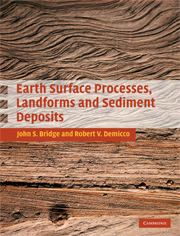Book contents
- Frontmatter
- Contents
- Acknowledgments
- Figure credits
- PART 1 Introduction
- PART 2 Production of sediment at the Earth's surface
- PART 3 Fundamentals of fluid flow, sediment transport, erosion, and deposition
- PART 4 Environments of erosion and deposition
- PART 5 Sediment into rock: diagenesis
- PART 6 Long-term, large-scale processes: mountains and sedimentary basins
- 20 Tectonic, climatic, and eustatic controls on long-term, large-scale erosion and deposition
- References
- Appendix: Methods of study of Earth surface processes, landforms, and sediments
- Index
- Plate section
20 - Tectonic, climatic, and eustatic controls on long-term, large-scale erosion and deposition
from PART 6 - Long-term, large-scale processes: mountains and sedimentary basins
Published online by Cambridge University Press: 05 June 2012
- Frontmatter
- Contents
- Acknowledgments
- Figure credits
- PART 1 Introduction
- PART 2 Production of sediment at the Earth's surface
- PART 3 Fundamentals of fluid flow, sediment transport, erosion, and deposition
- PART 4 Environments of erosion and deposition
- PART 5 Sediment into rock: diagenesis
- PART 6 Long-term, large-scale processes: mountains and sedimentary basins
- 20 Tectonic, climatic, and eustatic controls on long-term, large-scale erosion and deposition
- References
- Appendix: Methods of study of Earth surface processes, landforms, and sediments
- Index
- Plate section
Summary
Introduction
Earth surface processes that operate over relatively short time spans (less than a million years) and small areas (such as floodplains, beaches, and deep-sea fans) have been described up to this point. Interpretation of the landforms and sediment deposits that originate from such small-scale, short-term processes is based on field observations, laboratory experiments, and theoretical models. Mountain ranges and sedimentary basins are large-scale features of the Earth that formed over much longer time periods (millions of years). Sedimentary basins commonly contain stratigraphic sequences of diverse types and scales that were deposited in the various sedimentary environments described in Part of this book (Leeder, 1993, 1999; Miall, 1996, 1997). However, these sequences are much more extensive than those described in previous chapters (hundreds of meters to kilometers thick and tens to hundreds of kilometers in lateral extent) and may contain regional unconformities that indicate major interruptions to deposition.
Definition of the three-dimensional (3D) geometry and spatial distribution of different stratal types in sedimentary basins requires some combination of extensive exposures, high-resolution (preferably 3D) seismic data, many closely spaced cores or borehole logs, and accurate age dating (the methodology is given in the appendix). Such data are commonly lacking or incomplete, and it is necessary to “fill in” 3D space in order to produce a complete (and hypothetical) model of sedimentary architecture.
Information
- Type
- Chapter
- Information
- Earth Surface Processes, Landforms and Sediment Deposits , pp. 703 - 741Publisher: Cambridge University PressPrint publication year: 2008
